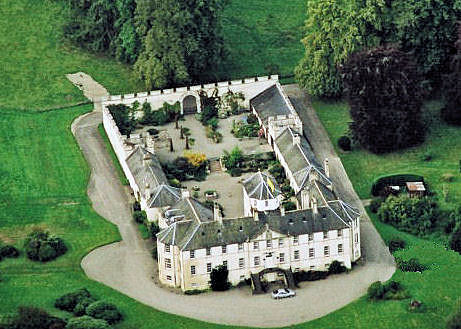
Graphic copyright © Scotavia Images
Scottish Castles Photo Library
- Foulis Castle, Ross and Cromarty

Tradition says that in the 11th century, the Foulis estate north-east of Dingwall and overlooking the Cromarty Firth, was given to the clan chief of the Munros for assisting King Malcolm II repel Viking invaders from Scandinavia. Part of the tradition says that the agreement under which the estate was granted included the requirement that the Munros had to produce a snowball in summer, if required to do so! More certainly, the remains of a mound with a defensive palisade on top (called a motte), dating from that time, can still be seen in the grounds of the present castle.
A Tower of Foulis (from the Gaelic "Fo-glais" a streamlet) was built in 1154 and the Munros developed this into a large and impressive defensive castle. In the 14th century, it was referred to as the Tower of Strath Skiath and was described as a "castle gaunt-peaked, the eagle's nest". Clansmen were summoned in times of warfare (which was often) by a fire being lit in its highest tower. The Munro rallying cry thus became "Casteal Foulais na theine," meaning Castle Foulis ablaze.
Members of the clan participated in the Battle of Bannockburn in 1314 and Halidon Hill in 1333. In 1547 the chief and many of his men fell at the Battle of Pinkie. A number of Munros, including the clan chief, served in armies abroad, particularly in Sweden during the Thirty Years' War. During the Civil War in the 17th century, a number of Munros fought at the Battle of Worcester in support of Charles II. Following this, Oliver Cromwell transported a number of Munros to New England where they flourished - James Monroe became fifth President of the USA.
Like a number of Presbyterian clans (Campbells, MacKays and Grants) the Munros supported the Revolution, which saw James VII deposed in 1689 and William and Mary accede to the throne. They did not support the Jacobite Uprisings by the Catholic Stewarts in 1715 and 1745. Colonel Sir Robert Munro, the 6th Baronet, was killed at the Battle of Falkirk in 1746, fighting on the side of the government forces against Prince Charles Edward Stuart. Foulis Castle was badly damaged by the Mackenzies who were Jacobite supporters.
The castle was rebuilt (incorporating parts of a 15th century tower house in the east wing) but as the need for a defensive castle receded, the design and layout was more in the style of the large mansion house we see today. The courtyard, with its entrance of three arches, with its semi-octagonal tower dated 1754, hints at an earlier form of Scottish architecture, while the white harled E-plan layout has a continental influence. During 20th century restorations, it was found that the original castle walls at ground level were five feet six inches thick.
The castle is still occupied by the chief of the clan Munro. Access by the public can only be made by prior arrangement.
Note: The photos of Foulis Castle on this page are copyright Scotavia Images who provide a quality aerial photography service for Scotland. Prints from their large online gallery are available for purchase. If you have ancestors with a Scottish Highland origin, they can provide an aerial view of the area they came from!
Return to the Castles Photo Library Index
or go to the next castle:  Fyvie Castle.
Fyvie Castle.
Where else would you like to go in Scotland?
Where else would you like to go in Scotland?

